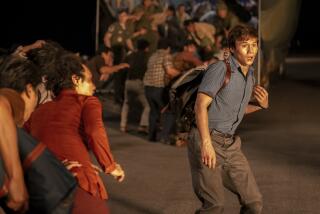No Hope From Hanoi : Families of MIAs Skeptical of Vietnam Initiative’s Worth
FULLERTON — Errol Bond doesn’t expect any miracles to follow this week’s announcement by the Vietnamese government that it will share with U.S. investigators all the information it has on American servicemen missing in Southeast Asia.
Bond’s son, Air Force Capt. Ronald L. Bond, then 23, was in a jet fighter that disappeared over Laos on Sept. 30, 1971.
In the intervening years, Bond and his wife, Madeline, of Fullerton, have done everything they could think of to ascertain the precise fate of their son. And what they have discovered, among other things, is evidence that they say strongly suggests that Ronald survived the crash of his airplane and, conceivably, could be alive today.
“We haven’t even been able to get from the (U.S.) government the results of its own investigation,” said Bond, 77.
All of which makes him strongly doubt that Friday’s announcement regarding the accord with Vietnam is anything but window-dressing, Bond said.
“These are photographs, presumably, of dead people,” he said of the historical material expected to be turned over to U.S. officials. “There is too much concentration on bodies and not enough effort being expended on (finding) live POWs. The only breakthrough is that it gives our government an opportunity to say that the Vietnamese are helping out as much as they can, so we can go back in there and give them recognition. Personally my feeling is that the almighty dollar is behind it; it’s a big push to normalize relations so that we can do business with Vietnam.”
Indeed, the Vietnamese announcement came on the heels of statements by President Bush and White House officials suggesting that normalization of relations between the two countries could come before Jan. 20. “We can begin writing the last chapter of the Vietnam War,” Bush said Friday following the announcement.
Among other things, officials said, the Vietnamese government would turn over tens of thousands of combat photographs and field reports, equipment and artifacts such as helmets and flight suits, identification cards and various documents. Included among the artifacts, they said, would be such things as aviators’ vests bearing the pilots’ names.
“Hanoi’s records will at last enable us to determine the fate of many of our men,” Bush said Friday, “and we still await the return of their remains. We may never know what happened to each and every American, but we will spare no effort to learn the truth.”
Bush said U.S. officials got their first glimpse of Vietnam’s war archives last summer after some of the material was released to a historical researcher named Ted Schweitzer. Then last weekend, retired Gen. John Vessey led a U.S. delegation to Hanoi to clinch the deal.
But Bond’s cynicism regarding the outcome is shared by other area relatives of POWs.
Deborah Robertson-Bardsley, whose mother, Barbara Robertson, lives in Santa Ana, was only 11 when her father, Air Force Lt. Col. John L. Robertson, was shot down near Hanoi on Sept. 16, 1966. Last July he appeared to be one of three Americans in a widely published photograph purporting to prove that POWS were still alive in Vietnam. And Robertson-Bardsley says a recent visit to the crash site, as well as numerous reported sightings of her father, have convinced her of the strong possibility that he is alive.
“It’s turned our lives around,” she says of her own research into her father’s fate. Because the U.S. government doesn’t want to have to explain to the American people why it left U.S. servicemen behind, she contends, it is much more interested in uncovering evidence of dead POWs than live ones. Thus any evidence released by Vietnam, she says, must be evaluated in light of America’s efforts to put the issue behind it.
“A lot of us believe that this is a smoke screen,” she said of the latest announcement. “It will take a while to find out if any of this stuff is new.”
Pentagon officials list 2,226 U.S. servicemen as missing in Indochina. Of those, they say, 74--including Robertson-Bardsley’s father--are listed as unsolved “discrepancy” cases, those in which a soldier is thought to have survived a crash but never surfaced as a prisoner of war.
By Friday, some of the thousands of photographs released by Vietnam--thought to be only a small fraction of the total number to be released--had already provided new information on the loved ones of three MIA families. The only family identified so far is that of Maj. Joseph Morrison of Lexington, Ky., who was 38 when his plane was shot down Nov. 25, 1968.
Unlike with other kinds of losses, Robertson-Bardsley said, the pain experienced by the relatives of a missing person doesn’t ease with time. “When someone dies the years make the loss easier,” she said, “but when someone is missing, the years make the loss harder. This isn’t an issue that’s going away--it’s getting deeper and deeper.”
MIA PHOTOS
Images are a treasure trove for U.S. analysts. A6
More to Read
Sign up for Essential California
The most important California stories and recommendations in your inbox every morning.
You may occasionally receive promotional content from the Los Angeles Times.










